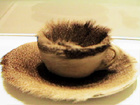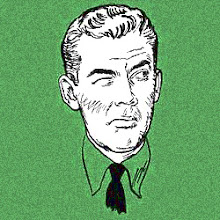
Nicholas Joost had been a Chicago-area professor and, for several years in the early 50s, was an associate editor at
Poetry magazine. After a while his main interest became
The Dial, the avant-garde magazine whose heyday had been the 1920s. Eventually he would write several books about the
Dial but first, from 1956 through 1960, he helped prepare a major exhibit on the
Dial put on at the Worcester Museum (in Massachusetts). Joost's manuscripts (at Georgetown) include correspondence of the late fifties and they seem (to judge from the finding aid) almost entirely taken up with the
Dial exhibit. I haven't seen the exhibit catalogue for the show, which opened in '59 and ran through part of '60, but I'm soon going to be in touch with the folks now at Worcester, get a copy of the catalogue and find out what institutional records they have kept. I've long been curious about specific reasons why the 1920s were so much the rage in the mid and late 1950s, why specifically Fitzgerald's fiction had such a comeback, why American modernists circa 1925 was of such great interest. This
Dial show and its reception will, I think, give me some further clues.
 In the photo: Mario Ellis Hill performs Bob Kaufman's Does the Secret Mind Whisper? A series of YouTube videos capture various poets honoring Kaufman's legend.
In the photo: Mario Ellis Hill performs Bob Kaufman's Does the Secret Mind Whisper? A series of YouTube videos capture various poets honoring Kaufman's legend.
















 Is '60 the moment when the end of the end of the Old Left had been reached and the New Left began to emerge? Is it the final ascendancy, in certain scenes at least, of poetic postmodernity? Surely the publication of Donald Allen's The New American Poetry that year suggests this, but then again--once again--we look back on "New" here and see continuity. The rhetoric of the Kennedy-Nixon contest made much less of a dent than everyone (at the time as well as since) claimed, so one wonders why were such great claims made?
Is '60 the moment when the end of the end of the Old Left had been reached and the New Left began to emerge? Is it the final ascendancy, in certain scenes at least, of poetic postmodernity? Surely the publication of Donald Allen's The New American Poetry that year suggests this, but then again--once again--we look back on "New" here and see continuity. The rhetoric of the Kennedy-Nixon contest made much less of a dent than everyone (at the time as well as since) claimed, so one wonders why were such great claims made?  Had we come to expect "1960" to be truly ubiquitously modern in a way that the 1950s really were not--not quite? And what specifically does "modern" mean in the Kennedyesque talk then and now about the torch being passed to a new generation, etc.? The First Lady really meant "modernist" when Camelotians said "modern." What about the others across the new young cultural leadership? I've been surprised by how frequently the
Had we come to expect "1960" to be truly ubiquitously modern in a way that the 1950s really were not--not quite? And what specifically does "modern" mean in the Kennedyesque talk then and now about the torch being passed to a new generation, etc.? The First Lady really meant "modernist" when Camelotians said "modern." What about the others across the new young cultural leadership? I've been surprised by how frequently the  "Beat movement" was covered in 1960 in the mainstream press. I was expecting a fair measure but I've found tonnage. 1960 was the year when the figure of the beat was beginning to find acceptance, although still 80% of these stories are mocking, rebels-without-cause condescension. For anyone whose analysis made an impact nationally, do these antipolitical adolescents count as part of the "new young cultural leadership"? No, but rather than the two being opposites, they fall along a Continuum of the New American. Now that's a change for '60.
"Beat movement" was covered in 1960 in the mainstream press. I was expecting a fair measure but I've found tonnage. 1960 was the year when the figure of the beat was beginning to find acceptance, although still 80% of these stories are mocking, rebels-without-cause condescension. For anyone whose analysis made an impact nationally, do these antipolitical adolescents count as part of the "new young cultural leadership"? No, but rather than the two being opposites, they fall along a Continuum of the New American. Now that's a change for '60.







